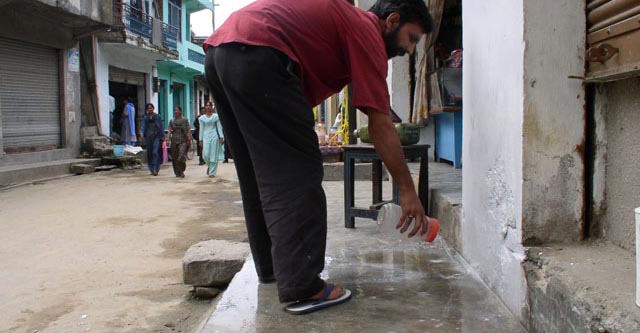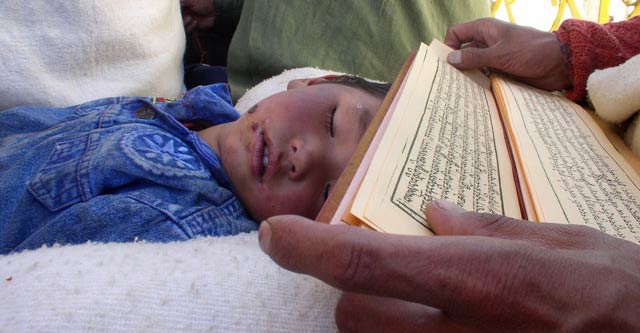29 november 2003 — offtrack
Manish Kumar, Indian sign-painter
India is covered with hand painted signs; shop titles, highway advertisements, movie posters and even license plates on cars are done by hard boiled sign-painters. Manish Kumar, 33, came to the small village of Rewalsar, Himachal Pradesh, for a month to paint seven new signs for local shops. To work as a sign painter in northern India, one must be familiar with English, Hindi and Tibetan scripts.
Manish is the second eldest brother of a family of four brothers and three sisters. 14 years ago his big brother taught him the basic lettering skills, likewise for the younger brothers, and later, for his own three sons. Currently, all seven men work for the family company, Artline Studio, at Mandi (a winding 24 km road down from Rewalsar), and are the best known sign painters in town. Manish himself has an 8-year old ‘baby’ and a 4-year old son. And a wife of course.
Sami was lucky to meet Manish while he was in the middle of lettering for a kiosk. After a short discussion with the ‘video/film maker’, Manish found himself painting one more sign, for Underware. Thank you, Manish!
—
If you want to get in contact with Manish, please write to:
Manish Kumar
Artline Studio
Ram Nagar, Distt. Mandi (H.P.), India
24 november 2003 — offtrack
Tibetan script on the rocks
Take the countries with the lowest and highest elevations in the world, the Netherlands and Tibet. Is there any difference in the typography they produce? While the Dutch types are sometimes considered horizontal and flat-ly curved (thanks to Gerard Unger), the Tibetan script is surely the opposite. It’s a world of vertical, edgy and steep curves, like the mountains where Tibetain script was born.
The Tibetan culture, while slowly but surely vanishing from Tibet itself, continues to settle down in its temporary refugee state, Himachal Pradesh, India, as does the script. It appears most permanently on the stone cuts which carved deep into the rocky range of the Indian Himalaya. You are most likely to see a boulder with a huge mantra reading ‘on mani padme hung’ carved on it. Each syllable has its own colour and meaning. With chanting the mantra a practitioner receives a blessing from Avalokiteshvara, the buddha of compassion. As His Holiness the Dalai Lama is the incarnation of this divine deity, it’s no wonder that this mantra is so widespread.
Originally the Tibetan script was developed in the 7th century from a Kashmiri version of the Sanskrit script by the scholars who returned from India. This was the time when Buddhism was introduced and the vast need for its own literature began. Currently the spoken language differs greatly from the written form, so much so that as an outsider it’s extremely hard to know whether a letter should be pronounced or is silent (many entire written syllables are silent when spoken). So forget about learning to write Tibetan, just look at these photos instead. These were taken by Sami in Himachal Pradesh, India, while he was traveling there in the Autumn of 2003.
18 november 2003 — offtrack
Tibetan beauty and the beast
The analogy which compares the Tibetan landscape to typography doesn’t accurately reflect the characteristics of the Tibetan people. In general they are not edgy, sharp nor grand, but humble and compassionate. It’s very easy to recognize a Tibetan among Indians as he’s the one who’s not shouting at you in the market streets.
Still, today many Tibetans cross the border and become exiled to the neighboring countries like India. Many of the people in these photos have walked on high mountain glaciers for weeks to reach the border of Nepal, from where they continue on to India. Walking on these glaciers may sound like, fun but it isn’t. Not only does the extremely cold weather and thin air make it a pain, but so does the fact that they can only walk during the night and they can’t make a fire for cooking (otherwise they’re easily recognized by Chinese). Dharamsala has a special ‘tibetan children’s village’ to accommodate and educate the newcomers. As well as the Tibetan script-photos, these photos are taken all over the state of Himachal Pradesh.
The crowning of year 2003’s brand new Miss Tibet was an extraordinary beauty contest. Tsering Kyi found out that she was the only contestant from the other initial 10 applicants who had shied away before the start of the contest. So the jury had no choice but to choose her! She IS really beautiful, and full of inner strength (she read her own poetry on stage at the contest), which is perhaps due to the fact that she’s from an ordinary Tibetan nomad-family. We need more beauty queens like this!
—
Read more about the Tibetans at:
Tibetan Government in Exile
08 february 2003 — offtrack
CorelCup 02
After organising the first edition of the CorelCup, we thought a second edition would be a good opportunity for many teams to regain respect. But probably the Underware-team now lost all their respect while winning the tournament they organised themselves. What a shame! The CorelCup trophy is now hidden at the Underware-office, waiting for the third edition of the CorelCup tournament, hoping that another team will kick our ass, and win the third CorelCup in its full glory.
CorelCup animation
05 june 2002 — offtrack
CorelCup 01
First edition of the official CorelCup, the indoor football tournament for cultural wannabes. Participating teams: FC Burolamp, FC Coreldrol, FC Dumbar, FC Hansom, FK Lokaal 11, FK Lust, FC NLXL, FC Schwalbe, FC Type&Media, FC Underware and FC Unit1. Five software packages of CorelDraw were won by ‘the worst goalkeeper’, the craziest goal’, etc. First prize was not only a software package of the sponsor, but also a real cup including eternal fame. Well, eternal until the second edition of CorelCup.














































































































